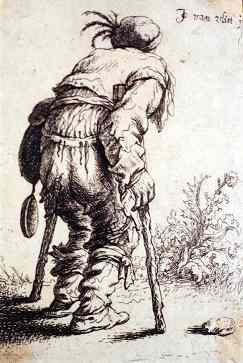Bedlam: madness
The institution called Saint Mary of Bethlehem, originally a priory, by the early fifteenth century had become a hospital* for the insane; its name, shortened to Bedlam, gives a clear idea of the scene that must have met visitors there.
And why visit? Not necessarily to see relatives, or to offer charity. The sight of the mentally disturbed became a spectacle, an entertainment*.
Madness, like disease, was seen as the result of an imbalance of the four humours: if there was an excess of the choleric humour the person was manic; if too melancholic, the person was depressed. Madness was especially disturbing because, in defiance of the natural order humans became like beasts when they lost their power of reason*.
Click to hear Theseus' thoughts on madmen and poets*.
Melancholia
Melancholia seems to have been widespread in the period; Antonio, in The Merchant of Venice, was by no means alone. Writers like Timothy Bright and, after Shakespeare's death, Robert Burton (The Anatomy of Melancholy) explored the phenomenon with wit and learning.
Hamlet, guessing why Rosencrantz and Guildenstern are at court, explains his madness (or "madness") as melancholy: "I have of late, but wherefore I know not, lost all my mirth, foregone all custom of excercises; and indeed it goes so heavily with me that this goodly frame, the earth, seems to me a sterile promontory; this most excellent canopy, the air, look you, this brave o'erhanging firmament, this majestical roof, fretted with golden fire, why it appeareth nothing to me but a foul and pestilent congregation of vapours" (2.2.303-311).
One of the recognised sources of excessive melancholy was love, unrequited love in particular. Thus it is not surprising that Polonius decides that Hamlet is mad for Ophelia's love; there is a bitter irony in Ophelia's madness, triggered in part by her rejection by Hamlet.
(Click for melancholy as one of the four humours.)
Footnotes
-
Hospitals
The government was increasingly accepting the need for care of the sick and needy. In London there were also Christ's Hospital for children, Bridewell for vagrants, and the two hospitals for the sick, St. Thomas' and St. Bartholomew's.
-
Bedlam on stage
Shakespeare does not show scenes inside Bedlam, but some of his contemporaries did. Thomas Middleton (in collaboration with Rowley), in The Changeling, shows several scenes in the asylum: the inmates are threatened with whips if they show any spirit, and are being trained to provide entertainment at a lord's banquet.
In John Webster's The Duchess of Malfi, the Duchess' brother -- who himself later suffers from lycanthropia -- torments her with a show of madmen.
Those who suffer from lycanthropia believe themselves to be wolves; it was thought to develop from extreme melancholia. Ferdinand, after he has ruthlessly killed his sister, says that the only difference between him and a wolf is that the wolf's skin is hairy on the outside, his on the inside (5.2.17-18).
-
Theseus on poets and madmen
In A Midsummer Night's Dream (5.1.7-22), Duke Theseus draws a parallel between three kinds of "madness": the lunatic, the lover, and the poet. (As with all passages read in this program, the pronunciation is what Shakespeare himself would have used. Click for more on his pronunciation.)
Listen to his speech:
-
The loss of reason
Hamlet's distress at his mother's rapid change of loyalty from his father to Claudius prompts this comment: "O God, a beast that wants [lacks] discourse of reason/Would have mourned longer" (1.2.150-51).
